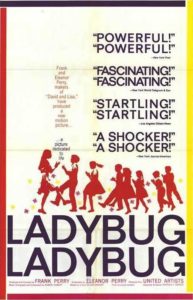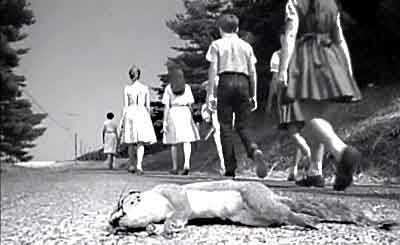 A most unjustly overlooked American independent production from director Frank Perry. An eccentric cold war drama, LADYBUG, LADYBUG (1963) is a superbly made film boasting flawless performances and a uniquely chilling atmosphere of creeping doom.
A most unjustly overlooked American independent production from director Frank Perry. An eccentric cold war drama, LADYBUG, LADYBUG (1963) is a superbly made film boasting flawless performances and a uniquely chilling atmosphere of creeping doom.
…a superbly made film boasting flawless performances and a uniquely chilling atmosphere of creeping doom.
As 60’s cold war thrillers go, LADYBUG, LADYBUG stands alongside better known classics like FAIL-SAFE, THE BEDFORD INCIDENT and even DR. STRANGELOVE. It’s certainly the most unique of the bunch, being set amidst a group of school children caught up in a possible nuclear attack.
Anyone at all familiar with the eccentric filmography of the late Frank Perry, one of America’s pioneering independent filmmakers, shouldn’t be too surprised. LADYBUG, LADYBUG was only Perry’s second film (following his successful debut DAVID AND LISA), but it’s definitely the work of a fully developed talent further showcased in subsequent sleepers like THE SWIMMER, LAST SUMMER, PLAY IT AS IT LAYS and MAN ON A SWING. The sad thing is that, despite such auspicious achievements, Perry is better known nowadays for later flicks like the Christopher Reeve mess MONSIGNOR, the Shelley Long turd HELLO AGAIN and the infamous MOMMIE DEAREST (ironically one of his most memorable films, though for all the WRONG reasons).
LADYBUG, LADYBUG was superbly scripted, like most of Perry’s early work, by his (then) wife Eleanor, from a story by Lois Dickert that was in turn inspired by a real incident.
LADYBUG, LADYBUG was superbly scripted, like most of Perry’s early work, by his (then) wife Eleanor, from a story by Lois Dickert that was in turn inspired by a real incident. A nuclear alarm is set off in a secluded provincial school, (this was back in the days when American schools had such things), lights that flashed different colors corresponding to various disasters. In this case the flashing light is yellow, meaning a nuclear attack is imminent. After much panicked discussion, the principal decides to take the alarm seriously, calling an assembly and ordering the teachers to walk their students home.
These walks take the form of nightmarish treks over miles of country roads, with the children following the teachers in groups of fifteen or so. We follow one such group, as the teacher grows increasingly exhausted in her high heels and the children succumb to panic. We also look in on the children as they return home: one of them hides under her bed after her parents refuse to believe her frantic warnings of an impending attack. Another locks himself in his basement with his schizophrenic grandmother. Most memorable are a group of children who hide out in a bomb shelter owned by the parents of a callous adolescent girl, who runs the place with an iron fist, leading to a disturbing LORD OF THE FLIES-type situation.
Of course, the alarm is eventually found to be false, the result of faulty wiring, but that doesn’t stop the panic from running its horrific course. The heartbreaking finale is possibly the film’s most effective sequence, involving a deserted junkyard, an abandoned refrigerator and the unnerving specter of bomber planes flying overhead.
The heartbreaking finale is possibly the film’s most effective sequence, involving a deserted junkyard, an abandoned refrigerator and the unnerving specter of bomber planes flying overhead.
One of LADYBUG, LADYBUG’S most effective aspects is its lazy country setting. Frank Perry, in direct contrast to the type of hysteria one would expect, utilizes deliberate pacing and a disconcertingly quiet atmosphere to enhance the aura of mounting fear. The very stillness of the well-chosen, mostly outdoor locations only adds to the general disquietude. So effective is Perry’s subtle touch that when the film’s single bit of violence (hopelessly tame by most standards) occurs toward the end, it seems as shocking as any bit of celluloid brutality you’ll ever see. The crisp and shadowy black and white photography is superb, as is the acting–Perry has always been great with actors, and coaxes some of the finest child performances ever.
Quite simply: a great film that MUST be rediscovered!
See Also: On THE SWIMMER
Vital Statistics
LADYBUG, LADYBUG
United Artists
Director: Frank Perry
Producer: Frank Perry
Screenplay: Eleanor Perry
(Based on a story by Lois Dickert)
Cinematography: Leonard Hirschfield
Editor: Armond Lebowitz
Cast: Jane Connell, William Daniels, Estelle Parsons, Doug Chapin, Bozo Dell, Linda Meyer, Jennifer Stone, Donnie Melvin, Christopher Howard

